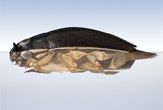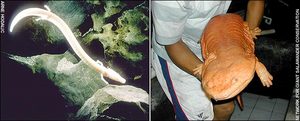OF THE
TIMES

|
| ©Charles J. Kazilek, Arizona State University |
| This lateral view shows the new species of whirligig beetle, revealing its divided eyes (above and below the water line) and its white underside. |

|
| ©Arne Hodauc/Network for Giant Salamnader Conservation |
| Olm (left) a blind salamander and Chinese giant salamander (right) that can grow up to 1.8m in length |